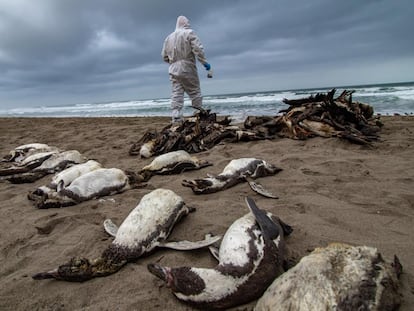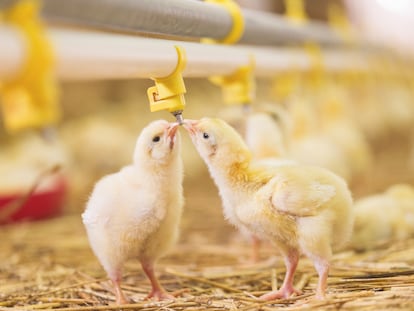The spread of bird flu virus on US dairy farms alarms WHO
Analysis shows a high viral load in the raw milk of infected animals. How the pathogen is spreading between cows remains unclear

The World Health Organization (WHO) on Monday expressed concern about the outbreaks of avian flu detected on dairy cow farms in the United States. “It is a cause for concern that the virus is infecting new species [of animals] and, with this, increasing the number of people exposed to the pathogen,” said the agency’s director for epidemics and pandemics, Maria Van Kerkhove.
A total of 36 farms in nine U.S. states have so far detected cases of avian flu in their herds. The outbreaks were discovered in March after investigations began in January, when several farms noticed a drop in milk production. The symptoms presented by the animals are very mild or almost undetectable. Although investigations are still open, these suggest that the origin of the infections are most likely wild birds that came into contact with livestock.
How the virus spreads between cows remains a mystery. “It does not seem that transmission is through the usual forms of respiratory infections. Rather, it seems that some element used in milking the animals is what facilitates the spread of the virus, although for now these are hypotheses under investigation,” said Richard Webby, the head of the WHO Collaborating Center for Studies on the Ecology of Influenza in Animals. The movement of livestock between farms would explain why the virus has been detected in dozens of farms. “It is very likely that the number of farms with cases is greater than the [36] officially detected,” he added.
So far, only one worker has been infected in connection with these outbreaks, a man from Texas who developed mild conjunctivitis-type symptoms, but not respiratory ones. The suspicion is that the virus got into his eyes when he scratched them with his infected hand after touching an infected cow.
The information offered at a meeting with experts and journalists on Monday reveals that the raw milk of affected animals has a high viral load, although the pathogens with the capacity to infect disappear with the pasteurization process. The WHO, like U.S. authorities, recommends not consuming milk or products made with raw milk, a minority but widespread practice in the country.
Available data also shows that up to 20% of tested milk on sale in affected states contains viral particles, although these are not infectious. The investigations carried out to date have not found viruses with the capacity to infect other products of animal origin such as meat and eggs in food sales circuits.
For now, the WHO continues to consider the risk to the general population “low,” and “low to moderate” for farm workers and other people exposed to livestock. Cats and raccoons infected with the virus have also been detected in farm environments.
No apparent risk to people
Despite this, WHO officials are concerned about the danger posed by the presence of the virus in livestock. Although for now there is no data to indicate a greater risk for people, the fact that the pathogen is circulating and spreading in mammals close to humans increases the likelihood that it will develop mutations that allow it to adapt.
The virus causing the outbreaks is A(H5N1) clade (variant) 2.3.4.4b, which emerged in 2020 and quickly spread throughout most of the world through migratory birds, causing the death of hundreds of millions of the species since then. In these four years, viruses have also infected other mammalian species, increasing concerns among experts as to whether the mutations that make this possible could bring the pathogen closer to adapting to humans. For now, however, this clade has had almost no impact on people. The WHO only has 13 documented infections in humans, almost all of them mild or very mild.
In a risk report published on April 23 together with the Food and Agriculture Organization of the United Nations (FAO) and the World Organization for Animal Health, the WHO warned that “Avian influenza A(H5N1) viruses, especially those of clade 2.3.4.4b, continue to diversify genetically and spread geographically,” which, together with the jump to mammals, gives the pathogen “increased opportunities for viral reassortment generating new genotypes with varied clinical signs.” An example of this is the detection of a new form of influenza A(H5N1) virus in poultry in Cambodia, Laos and Vietnam.
The document notes that “to date, there have been limited reports of transmission between mammals despite the increase in mammalian infections.” It also states that although direct evidence is lacking, the large mortality of marine mammals, the infection in multiple fur animal farms in Finland and mink in Spain are consistent with mammal-to-mammal spread.
Sign up for our weekly newsletter to get more English-language news coverage from EL PAÍS USA Edition
Tu suscripción se está usando en otro dispositivo
¿Quieres añadir otro usuario a tu suscripción?
Si continúas leyendo en este dispositivo, no se podrá leer en el otro.
FlechaTu suscripción se está usando en otro dispositivo y solo puedes acceder a EL PAÍS desde un dispositivo a la vez.
Si quieres compartir tu cuenta, cambia tu suscripción a la modalidad Premium, así podrás añadir otro usuario. Cada uno accederá con su propia cuenta de email, lo que os permitirá personalizar vuestra experiencia en EL PAÍS.
¿Tienes una suscripción de empresa? Accede aquí para contratar más cuentas.
En el caso de no saber quién está usando tu cuenta, te recomendamos cambiar tu contraseña aquí.
Si decides continuar compartiendo tu cuenta, este mensaje se mostrará en tu dispositivo y en el de la otra persona que está usando tu cuenta de forma indefinida, afectando a tu experiencia de lectura. Puedes consultar aquí los términos y condiciones de la suscripción digital.
More information
Últimas noticias
All the effects of gentrification in one corner of Mexico’s Colonia Roma
Palestinian reporter Youmna El Sayed: ‘My family told me I had to choose between being a journalist or a mother’
The new language of the workplace: Knowing how to ask AI questions is more important than using it
Russell Tovey: ‘I was advised many times not to come out, I don’t think there was many people who’d done that — and I feel really proud that I’m one of those that did’
Most viewed
- Christian Louboutin: ‘Young people don’t want to be like their parents. And if their parents wear sneakers, they’re going to look for something else’
- The low-cost creative revolution: How technology is making art accessible to everyone
- US sanctions against jailed cartel leader ‘El Marro’ highlight Mexico’s lack of control over its prisons
- Liset Menéndez de la Prida, neuroscientist: ‘It’s not normal to constantly seek pleasure; it’s important to be bored, to be calm’
- Cartels in Mexico take a leap forward with narco-drones: ‘It is criminal groups that are leading the innovation race’











































